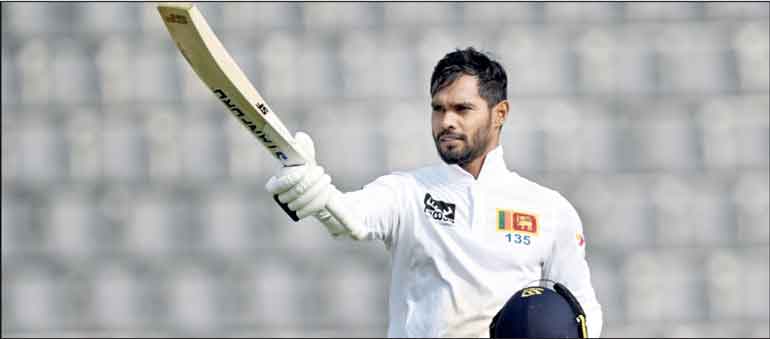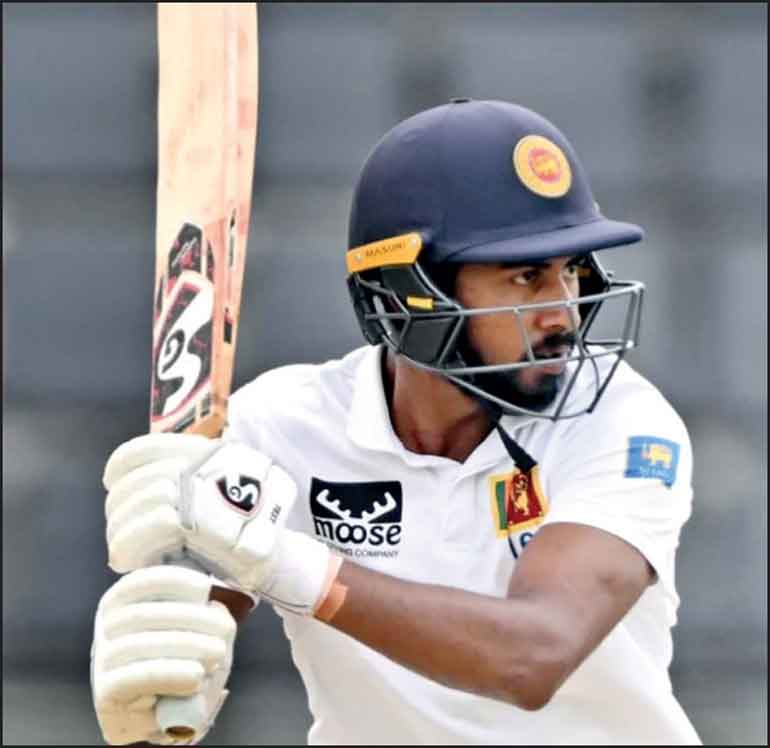Monday Dec 01, 2025
Monday Dec 01, 2025
Friday, 5 April 2024 00:30 - - {{hitsCtrl.values.hits}}

Dhananjaya de Silva not only showcased his skills with the bat but also on the field as a level-headed captain

Lahiru Kumara is going to get better the more he plays reckons coach Chris Silverwood

Kamindu Mendis has virtually sealed the number seven spot with his
batting exploits in the series
By Sa’adi Thawfeeq
There is certainly a marked difference in the approach of Test captain Dhananjaya de Silva (DDS) in comparison to the two white-ball captains Kusal Mendis (ODI) and Wanindu Hasaranga (T20I). The recently concluded two-match Test series established that De Silva was on a totally different plane to the other two by not going to the level of the Bangladeshis. At the end of the series when the team posed for the cameras with the silverware, there was no trolling as was witnessed at the end of the T20I and ODI series. De Silva would have none of that and how pleasing it was to see the discipline in the players, rather than trying to make clowns of themselves by riling the opposition.
De Silva said that there was no rivalry between the two teams following the infamous timed-out incident involving Angelo Mathews in the 2023 Cricket World Cup. “I don’t think there is any rivalry, it’s just a match between two nations. The game should be played with spirit and played hard. It happens in every match, not just against Bangladesh,” he said. The Lankan captain was exemplary in his leadership in the series and he set an example for the two white-ball skippers whose uncalled-for interactions with match officials only brought disrepute to the nation and fines and suspensions for them. Both Mendis and Hasaranga should understand that the game is bigger than the players and must not let their emotions get the better of them on the field, more so because they are leaders and must set an example for the rest of the team. Sri Lanka’s 2-0 defeat of Bangladesh in the series was only an extension of their dominance of the host country in Tests where they have emerged winners in all the Test series played there. Sri Lanka won by the same margin in 2006 and in 2008-09 under the captaincy of Mahela Jayawardene, and by 1-0 margins (1 drawn) in 2014, 2018, and 2022. Whereas spin played a decisive role in the wins in the first four series, Sri Lanka’s last visit to Bangladesh in 2022 saw a change towards seam with fast bowlers gaining the upper hand. Sri Lanka’s series-deciding 10-wicket win at Mirpur was on the back of fast bowlers Asitha Fernando (match bag of 10/144) and Kasun Rajitha (7/104) showing complete dominance of the Bangladesh batting.
So it was no surprise to see Sri Lankan fast bowlers once again playing a dominant part in their 2-0 series sweep. Lahiru Kumara (11 wickets, avg 12.63), Vishwa Fernando (10 wickets, avg 16.10), Kasun Rajitha (8 wickets, avg 14), and Asitha Fernando (4 wickets, avg 24) took a total of 33 of the 40 Bangladesh wickets to fall to bowlers even on dead pitches. “Our bowlers don’t need to have grass on the track to get wickets, and they proved that,” said De Silva in full praise of his quicks. “To get a wicket is really hard here. It’s very hot with the sun and there was not a lot of life on the pitch, so we had to work very hard. I like to play a more aggressive brand of cricket and go with fast bowlers. That’s why we went with three quicks. To have a series like this where the fast bowlers win for us is a big morale booster for the team.” Their performance should stand Sri Lanka in good stead for their next World Test Championship series when they tour England in August for three Tests provided the pacies keep themselves free of injuries. Since Chris Silverwood, a former England fast bowler took over as Sri Lanka’s head coach in 2022 the country’s fast bowling stocks have been rising so that at present, we have a stock of quality seamers at hand. Sri Lanka still relies heavily on spin at home especially at Galle but in the recent one-off Test against Afghanistan at the SSC, fast bowlers played a big part in the win taking 12 of the 20 wickets.
“I think they have been absolutely fantastic in this series. We have seen some good skill levels from the boys. They have shown a lot of heart, determination, and passion. I think they are learning how to bowl in different conditions,” said Silverwood. “We had a completely different style of pitch in the last Test. So we had to change the way we go about things. They adapted very well. They are growing. They have a lot left to learn. They are improving all the time.” Silverwood had a word of praise for Lahiru Kumara who made a comeback after a long injury layoff. He was the leading wicket-taker for Sri Lanka in the series with 11 wickets often troubling the batsmen with sharp short-of-a-length deliveries at speeds in excess of 140 plus.
“He (Kumara) has created an impact. He got wickets at important times. He bowled some fantastic deliveries. He has looked dangerous every time he has come into the attack. We want to continue to develop him. I think the more he plays, the better he is going to get.” For Sri Lanka, apart from the success of their pace bowlers, it was the batting of the captain De Silva and Kamindu Mendis that stood out in the series. It was their two game-changing partnerships in the first Test that enabled Sri Lanka to gain a foothold in the series and completely dominate Bangladesh. Mendis, in particular, who came in the place of out-of-form Sadeera Samarawickrama in the number seven slot, grabbed his chance with both hands to virtually seal that position with scores of 102, 164, 92*, and 9.